Theodor Aman
Theodor Aman (20 March 1831 – 19 August 1891) was a Romanian painter, engraver and art professor. He mostly produced genre and history scenes.[1]
Theodor Aman | |
|---|---|
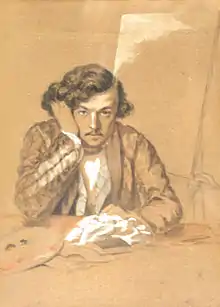 Self-portrait (1851) | |
| Born | 20 March 1831 Câmpulung-Muscel, Wallachia (today Romania) |
| Died | 19 August 1891 (aged 60) |
| Education | Michel Martin Drolling, Constantin Lecca, François-Édouard Picot, Carol Wallenstein |
| Known for | Painting, engraving |
Biography
His father was a cavalry commander from Craiova but he was born in Câmpulung, where his family had fled to escape the plague.[2] After displaying an early affinity for art, he took his first lessons with Constantin Lecca[3] and Carol Wallenstein de Vella at Carol I National College. In 1850, he went to Paris, where he studied briefly with Michel Martin Drolling then, after Drolling's death, with François-Édouard Picot.[3] While there, he became part of the Romanian revolutionary circles. In 1853 he has his first display at the Salon in Paris, showing his Autoportrait.[1] While in Paris, he became friends with other like-minded artists and Romanian revolutionaries such as Nicolae Bălcescu, and the writers Dimitrie Bolintineanu, and Cezar Bolliac. In this environment, influenced by revolutionary ideas, Aman completed the historical themed painting “Mihai VIteazul’s First Night”, which was inspired by the writings of Bolintineanu.[1]
As a result of his strong patriotic sentiments, he participated in the Romanian Revolution of 1848 along with Ioan Maiorescu, Eugeniu Carada, and other revolutionaries.[1]
After that, he went to Istanbul in an effort to sell some paintings to the Sultan and visited Sevastopol during the Crimean War, creating history paintings with themes related to Romania's nationalist aspirations.[2] In 1855, he presented one of his best-known works, depicting the Battle of Alma, at the Exposition Universelle.
He returned to Romania in 1857, settling in Bucharest where he starts the foundation of his school the Bucharest National University of Arts.[1]
When he returned home, he was knighted by Prince Barbu Dimitrie Știrbei and presented with a scholarship to continue his studies in Paris, where he came under the influence of the Barbizon school. After a brief stay in Rome, he returned to Bucharest.
In 1864, he and Gheorghe Tattarescu convinced Romania's ruler, Alexandru Ioan Cuza, to establish the "National School of Fine Arts" (now known as the Bucharest National University of Arts). Aman was appointed its first Director and held that position until his death.[2]
Theodor Aman remained headmaster of the school until he passed away. In 1889 and 1890 he displayed his work in exhibits at the New Museum. At this point in his career he chose to focus on painting still life, and small portraits.[4]
He died on 19 August 1891 due to a prostate infection.[1]
In 1908 his Bucharest his home and workshop was converted into the Theodor Aman Museum in dedication to his life and works. The museum is one of the oldest memorial museums in Romania and houses a large number of Aman paintings. The exhibit ”Theodor Aman — painter and engraver” was inaugurated on March 24, 2011 at the Controceni National Museum. The exhibit ”The mysteries of Theodor Aman’s painting,” was inaugurated at the Theodor Aman Museum on December 23, 2014. [4]
In 2014, to celebrate the 150th anniversary of the school's founding, Poșta Română issued a commemorative stamp with Aman's likeness.[4]
Selected paintings
 Gypsy Girl
Gypsy Girl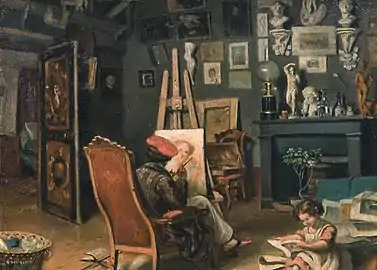 First Workshop in Paris
First Workshop in Paris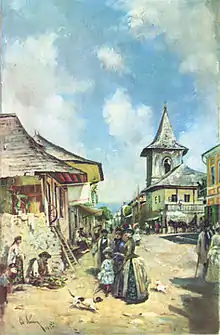 Street in Câmpulung
Street in Câmpulung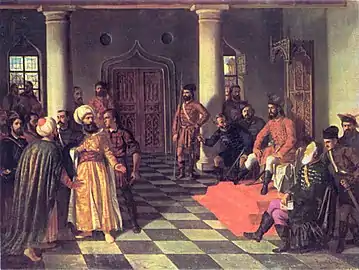 Vlad the Impaler and the Turkish Envoys
Vlad the Impaler and the Turkish Envoys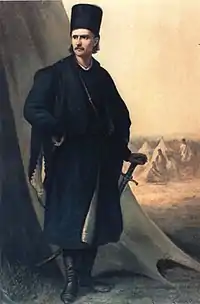 Portrait of Tudor Vladimirescu
Portrait of Tudor Vladimirescu
References
- Firuta, Corina (2009). Theodor Aman. Romania: Monitorul Oficial. p. 33. ISBN 978-973-96752-4-6.
- "Pictorul care a copilărit în curtea bisericii" (The Painter who Grew Up in the Churchyard) from Ziarul Lumina, 6 January 2010 ,
- Brief biography Archived 2015-04-02 at the Wayback Machine @ Welcome to Romania.
- "DOCUMENTAR: 127 de ani de la moartea pictorului Theodor Aman – Radio România Cultural". Retrieved 2019-11-14.
Further reading
- Vasile Florea and Călin Dan, Th.Aman, Ministry of Culture, 1984
- Teodor Simionescu and Adriana Gănescu, Theodor Aman 1831–1891, museum catalog, Fondul Plastic Arts, 1971
- B. Mosescu-Maciuca, Theodor Aman, Meridians, 1962
- Radu Bogdan, Theodor Aman, Editura de Stat Pentru Literaturǎ şi Artǎ, 1955
- Theodor Aman 1831–1891, Rumanian Institute for Cultural Relations with Foreign Countries, 1954
External links
| Wikimedia Commons has media related to Theodor Aman. |
- Aman, între conștiința istorică și hedonism (Between Historical Consciousness and Hedonism) by Adrian Silvan Ionescu from Ziarul de Duminică, 6 April 2011
- Muzeul Theodor Aman @ Muzeul Municipiului București